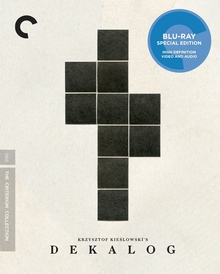The Decalogue (film)
| Dekalog | |
|---|---|

Blu-ray box set cover
|
|
| Directed by | Krzysztof Kieślowski |
| Produced by | Ryszard Chutkowski |
| Written by | Krzysztof Kieślowski Krzysztof Piesiewicz |
| Starring |
Artur Barciś see below |
| Music by | Zbigniew Preisner |
| Cinematography | Wieslaw Zdort Piotr Sobociński |
| Edited by | Ewa Smal |
|
Production
company |
|
| Distributed by | Warner Bros. (Poland) |
|
Release date
|
|
|
Running time
|
572 minutes |
| Country | Poland |
| Language | Polish |
| Budget | $100,000 (all parts) |
| Box office | $447,093 |
Dekalog (pronounced [dɛˈkalɔg], also known as Dekalog: The Ten Commandments and The Decalogue) is a 1989 Polish television drama series directed by Krzysztof Kieślowski and co-written by Kieślowski with Krzysztof Piesiewicz, with music by Zbigniew Preisner. It consists of ten one-hour films, inspired by the decalogue of the Ten Commandments. Each short film explores characters facing one or several moral or ethical dilemmas as they live in an austere housing project in 1980´s Poland.
The series is Kieślowski's most acclaimed work, was said in 2002 to be "the best dramatic work ever done specifically for television" and has won numerous international awards, though it was not widely released outside Europe until the late 1990s. In 1991, filmmaker Stanley Kubrick wrote an admiring foreword to the published screenplay.
The series was conceived when screenwriter Krzysztof Piesiewicz, who had seen a 15th-century artwork illustrating the Commandments in scenes from that time period, suggested the idea of a modern equivalent. Filmmaker Krzysztof Kieślowski was interested in the philosophical challenge, and also wanted to use the series as a portrait of the hardships of Polish society, while deliberately avoiding the political issues he had depicted in earlier films. He originally meant to hire ten different directors, but decided to direct the films himself. He used a different cinematographer for each episode except III and IX, in both of which Piotr Sobociński was director of photography.
The large cast includes both famous and unknown actors, many of whom Kieślowski also used in his other films. Typically for Kieślowski, the tone of most of the films is melancholic, except for the final one, which is a black comedy, featuring two of the same actors, Jerzy Stuhr and Zbigniew Zamachowski, as inThree Colors: White.
...
Wikipedia
